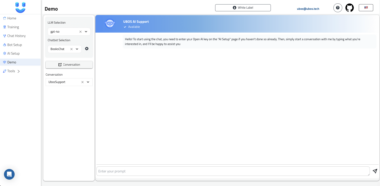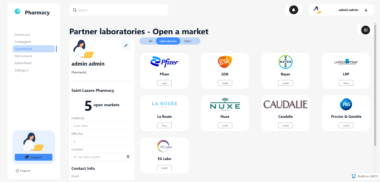UBOS Asset Marketplace: Unleashing the Power of Visuals with the Pexels MCP Server
In the rapidly evolving landscape of Artificial Intelligence, the ability for AI models to access and interpret real-world data is paramount. The UBOS platform stands at the forefront of this revolution, offering a comprehensive suite of tools designed to empower businesses in leveraging the full potential of AI Agents. One crucial aspect of real-world data is visual content. Recognizing this, UBOS is proud to feature the Pexels MCP Server in its Asset Marketplace.
This Model Context Protocol (MCP) server acts as a vital bridge, seamlessly connecting AI models with the vast and diverse library of photos and videos offered by Pexels. By integrating the Pexels MCP Server into their workflows, UBOS users can unlock a wealth of opportunities to enhance their AI applications, enrich data context, and drive innovation.
What is an MCP Server?
Before diving into the specifics of the Pexels MCP Server, it’s essential to understand the fundamental role of MCPs in the UBOS ecosystem. MCP, or Model Context Protocol, is an open standard that revolutionizes how applications provide context to Large Language Models (LLMs). Essentially, it acts as a universal translator, allowing AI models to easily access and interact with a wide range of external data sources and tools. Instead of being confined to static datasets, LLMs can leverage real-time information, dynamic content, and specialized functionalities through MCP servers.
The Pexels MCP Server: A Gateway to Visual Intelligence
The Pexels MCP Server is a prime example of the power of the MCP concept. It provides a direct and standardized interface for AI models to access the Pexels API, enabling them to search, retrieve, and utilize photos, videos, and curated collections. This integration opens up a vast realm of possibilities for AI applications, from content creation and marketing to data analysis and beyond.
Key Features of the Pexels MCP Server
- Comprehensive Search Capabilities: The server empowers AI models to conduct highly targeted searches for photos and videos based on a variety of criteria, including:
- Keywords: Utilize descriptive keywords to pinpoint relevant visuals. The documentation emphasizes using specific phrases like ‘Thai hotel reception’ rather than generic terms like ‘hotel’ for superior search accuracy.
- Orientation: Filter results by image or video orientation (e.g., landscape, portrait, square).
- Size: Specify the desired size of the image or video (e.g., large, medium, small).
- Color: Refine searches by dominant color.
- Locale: Target content relevant to specific geographic regions.
- Access to Curated and Popular Content: Beyond basic search, the server allows AI models to tap into Pexels’ curated collections and trending content, providing access to high-quality, engaging visuals.
- Browsing Pexels Collections: Seamlessly navigate and explore the diverse range of collections available on Pexels, enabling AI models to discover thematic visual resources.
- Detailed Information Retrieval: Obtain comprehensive metadata about specific photos and videos, including IDs, URLs, attribution details, and more.
- Direct URI Resource Access: Access specific photos, videos, or collections directly using URI addresses, simplifying integration and streamlining workflows.
Use Cases: Unleashing the Potential of Visual AI
The integration of the Pexels MCP Server into the UBOS platform unlocks a multitude of use cases across various industries and applications. Here are just a few examples:
- Content Creation and Marketing:
- Automated Content Generation: AI models can automatically generate visually appealing blog posts, social media updates, and marketing materials by leveraging relevant images and videos from Pexels.
- Enhanced Ad Creation: Optimize ad campaigns by incorporating compelling visuals that resonate with target audiences.
- Social Media Management: Schedule and automate social media posts with engaging visual content, increasing brand visibility and engagement.
- Data Analysis and Research:
- Image Recognition and Classification: Train AI models to identify and classify objects, scenes, and concepts in images and videos, enabling applications such as automated tagging and content moderation.
- Sentiment Analysis: Analyze the emotional tone and sentiment expressed in images and videos to gain insights into customer preferences and market trends.
- Visual Data Mining: Extract valuable information and patterns from large datasets of images and videos.
- Education and Training:
- Interactive Learning Experiences: Create engaging educational materials with relevant visuals to enhance comprehension and retention.
- Virtual Tours and Simulations: Develop immersive virtual experiences using Pexels’ library of photos and videos.
- E-commerce and Retail:
- Product Visualization: Enhance online product listings with high-quality images and videos to showcase product features and benefits.
- Personalized Recommendations: Recommend products based on visual preferences and browsing history.
- Real Estate:
- Virtual Property Tours: Create immersive virtual tours of properties using Pexels’ library of interior and exterior photos and videos.
- Automated Property Marketing: Generate visually appealing marketing materials for real estate listings.
Integrating the Pexels MCP Server with UBOS
Integrating the Pexels MCP Server into your UBOS workflows is a straightforward process. The server is designed for easy deployment and configuration, requiring only a Pexels API key. UBOS provides comprehensive documentation and support to guide users through the integration process.
Steps for Local Development and Testing:
- Clone the Repository: Obtain the Pexels MCP Server code from the UBOS Asset Marketplace.
- Install Dependencies: Use a package manager like
pnpmto install the necessary dependencies. - Build the Project: Compile the code to prepare it for execution.
- Run in Development Mode: Start the server in development mode, providing your Pexels API key as an environment variable.
Deploying to Smithery (UBOS Deployment Platform):
- Add the Server to Smithery: Integrate the Pexels MCP Server into your Smithery account.
- Deploy the Server: Initiate the deployment process.
- Configure the Deployment: Provide your Pexels API key in the configuration settings.
Leveraging UBOS for AI Agent Orchestration
The UBOS platform goes beyond simply providing access to data sources like Pexels. It offers a comprehensive suite of tools for orchestrating AI Agents, connecting them with enterprise data, building custom AI Agents with your own LLM models, and creating sophisticated Multi-Agent Systems. By combining the Pexels MCP Server with the power of UBOS, businesses can create truly intelligent and adaptable AI solutions.
Conclusion
The Pexels MCP Server in the UBOS Asset Marketplace represents a significant step forward in empowering AI models with visual intelligence. By providing seamless access to a vast library of high-quality photos and videos, this integration unlocks a wealth of opportunities for innovation across a wide range of industries. As AI continues to evolve, the ability to understand and interact with visual data will become increasingly critical. UBOS is committed to providing the tools and resources necessary to enable businesses to harness the full potential of visual AI and stay ahead of the curve.
Pexels MCP Server
Project Details
- CaullenOmdahl/pexels-mcp-server
- Last Updated: 5/7/2025
Recomended MCP Servers
Open source MCP server for Vectara

A Mattermost integration that connects to Model Context Protocol (MCP) servers, leveraging a LangGraph-based Agent.

A fork of JetBrains MCP Server that adds real-time WebSocket monitoring of all MCP interactions
A MCP server implementation for hyperbrowser

MCP Framework starter template bolt

MCP server for Yahoo Finance

MCP server for Notion integration

A Model Context Protocol implementation for FHIR
A connector for Claude Desktop to read and search an Obsidian vault.

MCP server for Google Gemini 2.0 Flash image generation
 From vibe coding to vibe deployment. UBOS MCP turns ideas into infra with one message.
From vibe coding to vibe deployment. UBOS MCP turns ideas into infra with one message.





